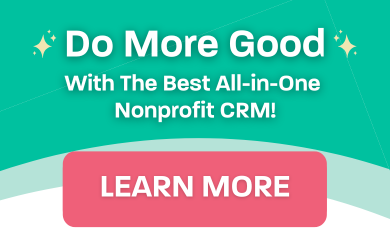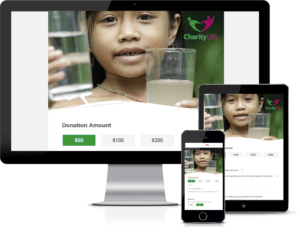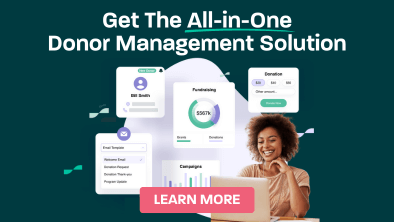
Getting new donors to give again isn’t easy. By some accounts, the average donor retention rate is only 43%!
Let’s put this into perspective – We know that it costs ten times as much to acquire new donors than it does to keep the ones you already have.
So why is it that keeping existing donors happy is low on almost everyone’s priority list, and fundraising teams still spend the majority of their time and energy bringing in new donors?
In order to help you raise more money for your nonprofit, we’re going to tell you exactly how to calculate your donor retention rate and some actionable donor retention strategies you can use right now to keep donors happy and motivated to give again.
Here’s what we’ll cover:
What is a Donor Retention Rate and Why Does it Matter?
Let’s get started with the basics.
Your donor retention rate is a measure of the percentage of donors from your existing pool of donors who continue to support your nonprofit year after year.
A high donor retention rate indicates a healthy fundraising program, with engaged donors that care about your work and see value in continuing to support it.
There are a number of reasons why donor retention should be at the top of your priority list:
- Recruiting new donors is difficult and costly: As mentioned earlier, the cost of getting new donors to your organization is high. On top of this, most first-time gifts are 2 to 3 times less than the cost of recruiting a new donor. If these new donors don’t give again, your fundraising and marketing costs will be higher than the donations you bring in.
- Repeat donations help build a strong, financially sustainable organization: Regular donors are the financial backbone of your nonprofit, providing a consistent, reliable flow of income. Having a large pool of monthly or annual donors you can depend on, helps build a more sustainable organization and inoculates your nonprofit against instability during uncertain economic times.
- Repeat donors are more likely to leave legacy gifts: Did you know that monthly donors are 6 times more likely to leave your nonprofit a legacy gift in their will? While their monthly donation amounts may be small, regular engagement with your organization can result in them leaving you a much larger sum in their will later on.
- Get access to wider networks: If your donors are impressed enough to regularly support your work, there’s a good chance they’ll recommend you to their friends and family. A high donor retention rate can help you leverage existing donor relationships to access wider networks and get donors’ friends and family to support your organization.
Now that you’re clear on why donor retention is so important, you can begin prioritizing it within your organization. But before we discuss how to do this, let’s learn how to calculate donor retention rate.
How to Calculate Donor Retention Rate
To measure your average donor retention rate, you’ll need to divide the number of last year’s donors who gave this year by the total number of donors last year, and multiply it by a 100 to get the percentage.
For example, if 100 donors from last year supported your organization out of a total of 250 donors, you retained 40% of your donors and lost 60%. Your donor retention rate is 40%.
Now, here’s how important retention rates are: Boosting donor retention rates by as little as 10 percent, can increase the lifetime value of a nonprofit’s donor base by up to 200%.
You can calculate the lifetime value of your donors to better understand how much your donors are worth you, to more clearly see the importance of acquisition costs and donor retention rates.
Tip: If you wanted to measure your retention rate for first-time donors, divide the number of first time donors giving a second gift by the total number of first time donors and multiply by 100.
Strategies to Increase Your Donor Retention Rate
Most nonprofits fall behind with donor management because they lack a clear donor retention strategy that prioritizes existing donors and keeps them engaged.
Here are a few key practices you can adopt to refocus your attention on existing supporters and increase your average donor retention rate:
#1: Make sure your donor’s first giving experience is a good one
A donor’s decision to stop giving to a charity can occur with the first donation they make.
Nonprofits often don’t realize how much the donation process can affect whether or not a donor decides to give again. If the process is lengthy and difficult, or your online platform doesn’t work seamlessly, donors will remember that experience when asked to give again and put it off for later, or simply never return.
It’s critical to take the time to optimize your donation page and make it as easy as possible for donors to give. Here are a few ways you can ensure this happens:
- Don’t send donors away from your website to give
- Only ask for essential information on donation forms
- Send an immediate thank-you and receipt
One of the main reasons donors don’t give a second gift is they didn’t receive a prompt acknowledgement of their gift.
If you are using Sumac Donations, not only do you get a sleek donation form that lives on your website, but donor information flows directly from your website into your database, and a thank-you email and receipt is sent out immediately, so you never have to worry about your donors not being thanked.
#2: Start a monthly giving program
If you don’t already have one, a monthly giving program is a fantastic way to increase your average donor retention rates. In fact, we created two calculators to help you determine just how much more you can raise with a monthly giving program.
A monthly giving program can be pretty easy to start and if you’re using Sumac Donations, the online donation form has the option for donors to give monthly.
#3: Personalize communication with donors
If you want to increase your donor retention rate, it’s time to step up your communications and show donors they are more than a transaction to you.
This means sending a personal thank-you email, providing updates on how their donations were used and personalizing communications as much as possible.
To better target donors based on their interests and communication preferences, segmentation to send tailored communication.
Remember, you want to make donors feel like they are more than a transaction, but valued partners in your mission. Donors who feel this way about your nonprofit are much more likely to invest in your work again!
#4: Invest in a donor management solution
Keeping track of your donors is difficult if you don’t have a good donor management solution. Manually tracking donors and gifts can get messy, especially if multiple people manage data in different locations.
They could end up contacting donors multiple times with little to no context of previous conversations. This alone can result in a donor ending their support.
Donor management software like Sumac Donations will help you get a clear picture of donor activity, including all communications and donations, so even volunteers can quickly see each donor’s relationship with your organization, including every interaction.
You’ll be able to engage donors easily and avoid making mistakes that can send them packing.
#5: Tell donors WHY their gift matters
One of the biggest mistakes nonprofits make is failing to close the loop after they receive a donation.
Sure, donors might receive a thank you message when donating (hopefully one that’s personalized!), but after that, they’re often forgotten until the next fundraising campaign.
This makes donors feel like they’re being asked to give again with little to no idea of how their money is being spent or whether it had an impact. And when they don’t know that, they won’t be motivated to keep on giving.
It’s important to regularly communicate with donors how their contributions make a difference. You can do this by:
- Including impact stories in your newsletter: Use your newsletter to keep donors updated on your recent successes and how donations contributed to this success.
- Documenting live impact stories on social media: Don’t wait for a project to be over before you start talking about it. Post small updates about your work on social media and allow donors to follow-along as you make progress.
- Sharing quarterly or annual reports: Provide donors a broader look at how your organization is moving towards its goals in your annual report. This will allow them to see the overall value and contribution you’re making to the wider community, and the part they’re playing.
Donors need to be assured that their money is going toward results that are lasting and effective, which is why their decision to give again hinges greatly on your organization’s ability to communicate its accomplishments.
#6: Get regular feedback
When you reach out to donors for feedback and pay attention to what they say, you’re telling them that you value the relationship.
Asking for feedback from donors is also vital in understanding why they continue to give, and can help identify gaps where you may be failing in communicating with them.
Addressing these pain points is an important step in improving your donor retention rate.
Here are a couple of ways you can create a regular feedback loop:
- Send out surveys shortly after events and campaigns – Don’t wait too long until you ask for feedback since people might forget about the experience. Donors are also more likely to answer a survey if it’s short.
- Host advisory councils or feedback meetings – An advisory council is a volunteer group formed to give advice and support to a nonprofit’s board of directors or executive staff. This group can help you get deeper insights into your organization’s retention efforts.
- Engage online with discussions on social media – This is a great way to get a broader sense of how people not connected closely to you view your organization.
Keeping donor retention rates high is a struggle for most nonprofits, but is vital for an organization’s growth and needs to be prioritized.
Find out more about why donor’s leave (and how to get them to stay) and learn about this ridiculously simple donor retention strategy if you’re really struggling to hold on to previous supporters.
Retaining the donors you attract to your cause is the key to sustainable growth. By focusing on making the giving experience a good one, effective communication, and meaningful donor engagement, you will be setting yourself up for future growth!




